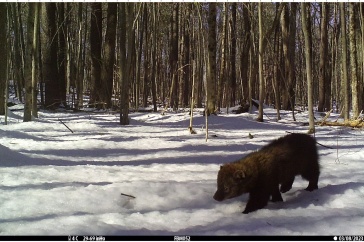
Photomicrograph from the biopsied mass showing a fungal spherule (arrow), consistent with Coccidioides, surrounded by inflammatory cells. Credit: NH Veterinary Diagnostic Lab
A pathologist with New Hampshire Diagnostic Veterinary Lab at UNH recently diagnosed the fungal disease Valley fever in a rescue dog from Arizona. It is the first time the lab has diagnosed the ailment in a dog in the state. The disease, which is treatable, is endemic in the Southwest and rarely seen in native New England dogs.
“This case serves as a reminder to inform your veterinarian of your pet’s travel history and the importance of submitting biopsied tissues for histopathologic examination even if the lesion seems routine,” says Colleen F. Monahan, senior veterinary pathologist and clinical assistant professor at New Hampshire Veterinary Diagnostic Lab and UNH. “This is especially important given the increased numbers of homeless dogs and cats being transported from southern states to New England for adoption. These animals may be infected with diseases that are endemic in those states but are not normally seen in this region.”
Monahan made the diagnosis after a mass on the leg of a New Hampshire dog, removed by a veterinarian, was submitted to the lab for biopsy. The inflamed mass was found to be the fungal disease Valley fever, an infection caused by the fungus Coccidioides.
“There are rare reports of people and animals from New England contracting Valley Fever after travelling to a region where it is more prevalent. In this case, we learned from the veterinarian that this dog was rescued from Arizona two years prior and had a small mass on its leg at that time. The mass recently had increased in size, leading to concern from the owner and removal by the veterinarian,” Monahan says.
According to the Valley Fever Center for Excellence at the University of Arizona, two-thirds of U.S. Valley fever infections are contracted in Arizona even though nationally, the disease is uncommon. People and animals can develop Valley fever after inhaling spores growing in loose, sandy soils most commonly found in the southwestern United States and northwestern Mexico. The disease is not zoonotic – it cannot be passed from animals to people or between animals.
The most common early symptoms of primary pulmonary Valley fever in dogs are coughing, fever, weight loss, lack of appetite and lack of energy, according to the Valley Fever Center for Excellence. Most dogs, with adequate antifungal therapy, recover from the disease, especially with early diagnosis and intervention.
“While there are tests that can be run to rule out Valley fever, since it is so rare a diagnosis in this region, screening testing of adopted dogs would be excessive. Instead, owners should inform their veterinarians if their animals were adopted from or traveled to different regions -- especially if the animal is sick -- so the veterinarian can have the whole picture to better diagnose and treat their pet,” Monahan said.
-
Written By:
Lori Tyler Gula, PhD | NH Agricultural Experiment Station | lori.gula@unh.edu | 603-862-1452

















































